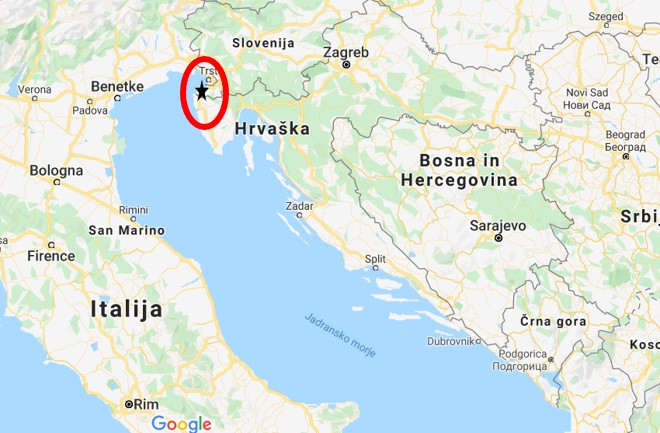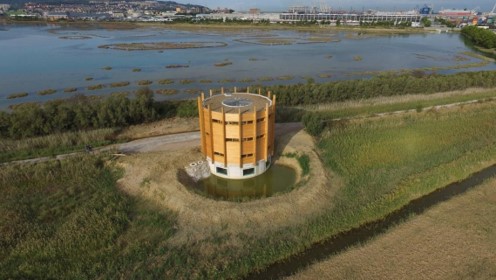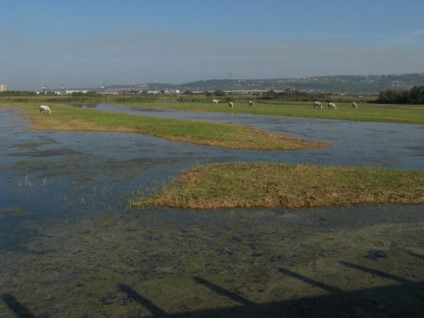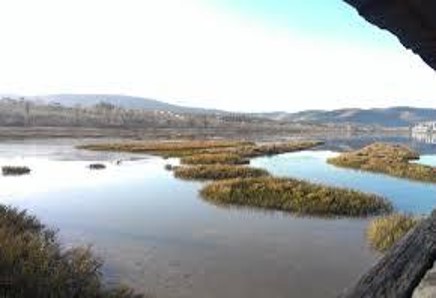Škocjanski zatok – restored coastal wetland enhancing resilience of the city of Koper

Geographic context and climate challenges
Škocjanski zatok is a remnant of a brackish wetland which once surrounded the city-island of Koper. Today, this Nature Reserve is an urban wetland representing a good example of the coexistence of the natural environment and urbanisation, which is making a city safe, resilient, and sustainable. The water sources of the wetland were the Rižana and Badaševica rivers and the seawater of the Gulf of Koper. The area of the wetland was diminishing due to the gradual draining of the wetland and the encroaching urbanisation, and with that its important bird and other flora and fauna habitats were also disappearing. The last remnants of the wetland, surrounded by the city of Koper, the rapidly developing port, the motorway and the railway were destined to be completely drained, filled-in, and transformed into an industrial area, according to spatial planning acts of the early 1990’s. Due to draining and filling-in, the aquatic areas of Škocjanski zatok shrank from the original 230 to mere 80 hectares. Having suffered a complete destruction of more than half its territory and severe degradation of the remaining habitats, Škocjanski zatok was on the edge of disappearing in 1993.
The municipal spatial plans were then changed on the request and after years of efforts invested by the DOPPS-BirdLife Slovenia, and the area was designated as nature reserve. Today the Škocjanski zatok Nature Reserve is the largest brackish wetland in Slovenia. With its surroundings, it is an ecosystem of unique habitats from wet meadows, shallows and mudflats, tidal areas, shores and a brackish marsh to reedbeds and freshwater marsh, which provides high biodiversity. Furthermore, the area of the reserve is very important for flood protection, as it serves as a retention area during the Rižana River high-water levels. Moreover, this green space provides more favourable microclimatic conditions within the city of Koper, which is a considerable added value in the times of worsening climate change impacts.
The climate change models and simulations in Slovenia predict a significant increase in the average annual air temperature by the end of the 21st century across entire Slovenia and during all seasons. The rate of increase is dependent on the GHG emissions scenarios. The optimistic scenario forecasts by 2100 an average temperature increase of 1.3°C above the average for the 1981-2010 period, the moderately optimistic scenario expects an increase of 2°C, while the pessimistic scenario expects the raise of about 4.1°C.
A higher frequency and more prominent extreme weather events, including storms and heavy precipitations, particularly in autumn and winter seasons, are expected. This will result in more frequent river flooding as well, mainly by the Rižana and Badaševica rivers.
Objectives
The nature conservation objectives for the protection of the Škocjanski zatok as a nature reserve is the preservation of brackish and freshwater habitat types, which are outstanding in both Slovenian and international contexts, as well as bird habitats which are used by a great number of nesting, wintering and migrating birds. Other native wild animal and plant species are also protected.
The development goal of the nature reserve is the arrangement and functioning of the nature reserve open for public, which provides education, nature experience, and awareness raising of the visitors.
The climate change mitigation goal of the area is to regulate the outflow of high waters from the Rižana river in the cases of flooding, and mitigating extreme temperatures in the city of Koper.
Adaptation measures implemented in the case
Restoration and management of coastal wetlands
Adaptive management of natural habitats
Improving ecological networks and functional connectivity
Solutions
The first phase of the restoration of the area of Škocjanski zatok into its natural state was focussed on the preparation of initial analyses and data bases and awareness raising of the importance of the area from the ornithological point of view. The Inter-municipal Institute for the Protection of Natural and Cultural Heritage of Piran prepared a study on the protection of the natural and cultural heritage of Škocjanski zatok. The NGO DOPPS-BirdLife Slovenia and its Nature Protection Commission proposed a series of urgent measures to stop the degradation of the area – immediate termination of filling in of the existing water areas. The activities led to the project “Rehabilitation and Renaturation of Škocjanski zatok” in which DOPPS_BirdLife Slovenia launched a wide nature conservation campaign for the conservation and legal protection of the area.
As a result, Škocjanski zatok was temporarily declared a natural sight, based on an emergency decree issued by the Ministry of Culture in November 1993. In parallel, the Ministry of the Environment worked with DOPPS-BirdLife Slovenia to prepare a legal act for the permanent protection of the area.
In the next phase, the Škocjanski zatok Nature Reserve Act was adopted (1998). The Slovenian Parliament approved a five-year action plan for the protection and development of the area in the following year. In September 1999, following a public tender, DOPPS-BirdLife Slovenia was granted a ten-year license for the management of the reserve, the first case in Slovenia of an NGO managing a protected area.
A milestone in the sustainable development of the area was the LIFE-Nature project “Restoring and conserving habitats and birds in the Škocjanski zatok Nature reserve”, which was co-financed by the EU and the Port of Koper and implemented in the period 2001 – 2007. Within this framework, the following activities were carried out:
- Cleaning and deepening of the outlet of Ara, the left discharging channel of the Rižana river, and mounting of a sluice system on the sea channel were foreseen in order to improve the inflow of fresh and sea water to the lagoon;
- Removal of over 180,000 cubic metres of the sediment (mud) from the brackish lagoon and restoration of the habitats along the lagoon borders (shallow areas, mudflats of different heights, and creation of islets within the lagoon);
- Creation of a freshwater marsh in the Bertoška bonifika – to set up breeding habitats in order to replace similar habitats lost 20 years earlier;
- A circular nature trail was built around the entire freshwater marsh, together with embankments, channels, and bird-watching hides.
In the following period (2014-2016), a visitor centre was built, with all the corresponding facilities and new bird-watching hides and observation spots.
The management of the protected area maintains the good environmental status of the restored and newly created habitats, which is primarily focused on the management of water regimes, vegetation control through extensive grazing and late mowing, removal and eradication of non-native species and propagation of native species. Other vital management issues include the provision of infrastructure, visitor management, park ranger service, monitoring and research. In 2019, the concession for managing the nature reserve was renewed and awarded to DOPPS for the next 10 year period.
Functioning natural spaces provide some of the best nature-based solutions to combat the effects of climate change. Heterogeneous green areas decrease the creation of heat islands around cities, scatter the incoming radiation and thus raise the albedo effect, as well as capture and store considerable amounts of carbon. Nahlik and Fennessy (2016) claimed that wetland soils contain some of the highest stores of soil carbon in the biosphere. The preserved biodiversity further supports the functioning of wider ecosystems, thus improving regional ecosystem resilience and decrease the likelihood of devastating feedback loops and possible collapse of support systems due to climate change and other anthropogenic impacts.
Leader of the initiative and key partners
The key actor is undoubtedly DOPPS-BirdLife Slovenia. This NGO played a crucial role in the communication campaign on the ornithological importance of Škocjanski zatok, urgently warned about the need to stop further destruction of the habitats, and successfully animated the wider public in these efforts. Additionally, DOPPS-BirdLife Slovenia also lobbied at the ministerial level and with other decision-makers, which led first to the temporary protection and later to the designation of the nature reserve. After acquiring the concession, DOPPS-BirdLife Slovenia successfully manages the protected area and leads a variety of programmes for school children and wider public.
The Inter-municipal Institute for the Protection of Natural and Cultural Heritage of Piran prepared initial analyses in the initial phase, which served as a basis so that the evidence-based discussions on the protection of the area became possible at all.
The Ministry of Culture provided first the temporary protection, and later the Ministry of the Environment and Spatial Planning ensured the protection with the status of nature reserve. The latter also financially supports the management of the area.
The municipality of Koper cooperates with the implementation of some projects in the framework of the reserve’s programme of work.
The general public also expressed its support in the initial phase and thus exerted informal pressure on the decision-makers toward appropriate preservation of this important ornithological area.
Stakeholder participation
Communication with the general public was very important from the very beginning of the efforts for the preservation of Škocjanski zatok. In the framework of the project “Rehabilitation and Renaturation of Škocjanski zatok” (1993), DOPPS- BirdLife Slovenia launched a wide nature conservation campaign. An exhibition was organised with the presentation of a preliminary design for the regulation of the area as a nature reserve, open to the public. More than 7,000 supporters signed the petition calling for the authorities to stop the filling-in immediately and protect the lagoon, which backed the nature conservation efforts.
At the beginning, the Municipality of Koper was not in favour of the protection of Škocjanski zatok as a nature reserve. Due to a wide public support and owing to the on-going co-operation of the reserve manager and the competent Ministry during the restoration works, the attitude of the Municipality changed. Nowadays, the Municipality supports the nature reserve and various forms of co-operation have been established. The city of Koper successfully co-exists with the nature reserve at its border.
With the support of the LIFE III program, DOPPS-BirdLife Slovenia created a firm and successful partnership with the Ministry of the Environment and Spatial Planning for the organisation and management of Škocjanski zatok. This is a rare example of cooperation between governmental and non-governmental sectors in Slovenia.
In 2002, an informal network of North-Adriatic Wetlands’ managers was established to exchange experience and to establish joint promotion of the areas, and it is still active.
Success and limiting factors
The active and strong engagement of bird lovers (through the NGO, DOPPS-BirdLife Slovenia) was of vital importance for the protection of Škocjanski zatok with the aim to prevent the complete drainage and filling-in of the area, as well as the expert support of the then existing Inter-municipal Institute for the Protection of Natural and Cultural Heritage. After the successful exhibition presenting the topics at hand, the wider public also supported these efforts.
The wide public demonstrated their support for the petition which demanded immediate protection of Škocjanski zatok. The petition was signed by 7,000 citizens in a very short time, which is a significant proportion of the populace and could not have been ignored by the local political actors.
Successful communication and cooperation with the relevant ministries were established, which first enabled the temporary protection of the area, and later also the designation of the area a nature reserve in 1998. In the years that followed, the Ministry of the Environment and Spatial Planning also supported financially the restoration and maintenance of habitats, with the exemplary cooperation continuing to this day (awarding and extending the concession for the management of the reserve to DOPPS-BirdLife Slovenia).
The area of nature reserve lies at the very border of the only Slovenian commercial port (Port of Koper). Despite the initial mistrust, a good cooperation has been established over time, which can be a blueprint for the coexistence of a large company and a protected area. The Port of Koper also financially supported the implementation of some projects in the reserve.
The Municipality of Koper, in the initial phases, was not supporting the protection of the area, as they had planned to develop the area for urban functions. Later, the spatial plans were adapted to the nature reserve, and today the city successfully coexists with the reserve and collaborates with their development projects.
The reconciliation of the opposing interests regarding the development of the area and the establishment of productive relationships or coexistence with key local partners (the Municipality of Koper and the Port of Koper) is among the most important factors behind the successful development of the reserve. This required a great negotiating skill of the initiators, as well as the support of the ministries and the general public., The support of the general public particularly, with its wide-ranging support of the protection petition, was crucial in these developments.
An important element is also the successful management of the reserve, which is shown through efficient securing of funds from different sources (including EU funds) for the realisation of different projects. The administration also successfully implements a variety of programmes which attract ever growing numbers of visitors, which also solidifies the attractiveness of the area.
Costs and benefits
RESTORATION AND CONSERVATION OF HABITATS AND BIRDS IN NATURE RESERVE ŠKOCJANSKI ZATOK (LIFE00NAT/SLO/7226, Programme LIFE III Nature): designing the habitats in the freshwater part of the reserve and the lock on the Ara, an arranged lock system on the inflow and outflow of the Ara, shelter dykes and circular educational trail on the edge of the freshwater part of the reserve, removal of more than 180,000 m3 of mud from the brackish lagoon and arranged lagoon habitats, an established lock on the sea canal. Financing: cca. 3.1 million EUR (funding sources: EU (290,935 EUR), the Port of Koper (15,000 EUR), the national budget for the rest).
ŠKOCJANSKI ZATOK – CLASSROOM IN NATURE FOR EVERYONE (Programme Interreg SLO-ITA 2004-06) – successfully implemented public tender for the design of architectural objects and supplementing the landscape design in the reserve, completed project documentation for all planned objects and submitted application for the construction permit, achieved functionality of the educational trail prepared in the LIFE project. Financing: value of the project: 263,340 EUR (83.07% Interreg co-financing).
OBJECT IN NATURE RESERVE ŠKOCJANSKI ZATOK (Operational programme of enhancing regional development potentials for the period 2007-2013) – the majority of the funds were secured by the Ministry for the Economic Development and Technology from ERDF and national sources, VAT was co-financed by the Ministry of the Environment and Spatial Planning from the national budget and excess funds of the Agricultural Lands and Forests of the Republic of Slovenia Fund. Financing: value of project: 263,340 EUR.
Management of the park funding sources: national budget, commercial activities of the park (income from guided visits and various workshops, sale of products and drinks in the visitor centre, renting of halls) local, national and international funds, institutions or organisations, as well as international projects and donations.
The benefits of the protected area – reserve is linked mainly to conservation of habitats – biodiversity and to urban benefits, such as green spaces and recreational areas, while it also represents a nature-based solution against flooding since it can absorb large amounts of water during heavy rains and floods.
Contacts
Borut Mozetič
Naravni rezervat Škocjanski zatok
Sermin 50, 6000 Koper
tel.: 05 626 03 70
info@skocjanski-zatok.org
Source for more detailed information
https://www.skocjanski-zatok.org
Nahlik, A. M., & Fennessy, M. S. (2016). Carbon storage in US wetlands. Nature Communications, 7(1), 1-9.
Map

Pictures

Aerial photograph of the nature reserve Škocjanski zatok



Documents

